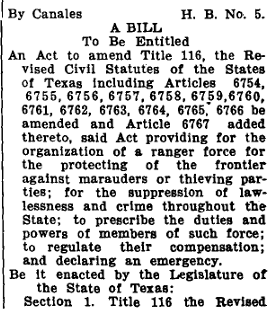#OTD in 2019 the film The Highwaymen premiered on Netflix. The film dramatizes #TexasRaners Frank Hamer and Maney Gault’s hunt for Bonnie and Clyde, and celebrates the Rangers’ seemingly unique ability to “take down” dangerous criminals. /1 

Bonnie Parker, Clyde Barrow, and their gang robbed banks and stores and killed at least 9 people between 1932 and 1934. They repeatedly evaded police capture, until a posse led by Hamer and Gault ambushed and killed them in Louisiana on May 7, 1934. / 2 

Told from the Rangers’ perspective, The Highwaymen positions itself as a ‘corrective’ to Bonnie and Clyde’s romantic Robin Hood image. It responds to the 1967 film Bonnie And Clyde, which depicts the outlaws as glamorous anti-heroes in the spirit of the ‘60s. /3 

While The Highwaymen is broadly accurate, it reinforces a key Ranger myth: that although they are scrupulously moral, they have a special ruthlessness and knowledge of the criminal mind that enables them to hunt and catch dangerous outlaws. /4
Two exchanges from the trailer demonstrate how the film portrays the Rangers as a special kind of law enforcement that’s more closely connected to the tenacity, violence, and justice of Texas’ ‘Wild West’ past. /5 



Even the Texas governor associates the Rangers with the old Wild West. But with Rangers’ capacity for old-fashioned violence—like beating up little shits in bars-comes a strict moral code, possibly stricter than that of modern law enforcement. /6
The film argues that this combo of force and morality enables Hamer and Gault to find and kill Bonnie and Clyde and avenge those they’ve hurt. /7 

Underneath this story is an idea about law enforcement: to stop violence, they must understand and commit violence, and civilians must trust their choices about when violence is necessary. Doubt of this idea is at the core of police accountability movements. /8 

In the Rangers’ case, that doubt is warranted. They participated in decades of state-sanctioned, racialized violence, often against civilians. The 1918 Porvenir Massacre is just one example. /9
https://twitter.com/Refusing2Forget/status/1619345581725593601?s=20
This thread is a part of the #OTD in Ranger history campaign that
@Refusing2Forget is running this year. Follow this twitter handle or refusingtoforget.org/ranger-bicente…, and visit our website refusingtoforget.org to learn more. /10
@Refusing2Forget is running this year. Follow this twitter handle or refusingtoforget.org/ranger-bicente…, and visit our website refusingtoforget.org to learn more. /10
Refusing to Forget members are @ccarmonawriter @carmona2208 @acerift @soniahistoria
@BenjaminHJohns1 @LeahLochoa @MonicaMnzMtz and @Alacranita, another co-founder is @GonzalesT956 /11
@BenjaminHJohns1 @LeahLochoa @MonicaMnzMtz and @Alacranita, another co-founder is @GonzalesT956 /11
@emmpask @sdcroll @HistoryBrian @LorienTinuviel
@hangryhistorian, @ddsanchez432!, @elprofeml, and @littlejohnjeff
are other scholars working on this project. /12
@hangryhistorian, @ddsanchez432!, @elprofeml, and @littlejohnjeff
are other scholars working on this project. /12
• • •
Missing some Tweet in this thread? You can try to
force a refresh

 Read on Twitter
Read on Twitter







![2: Penateka Marker] [alt text: this photo shows picture of](https://pbs.twimg.com/media/FrlYHurXsAAIN95.jpg)






